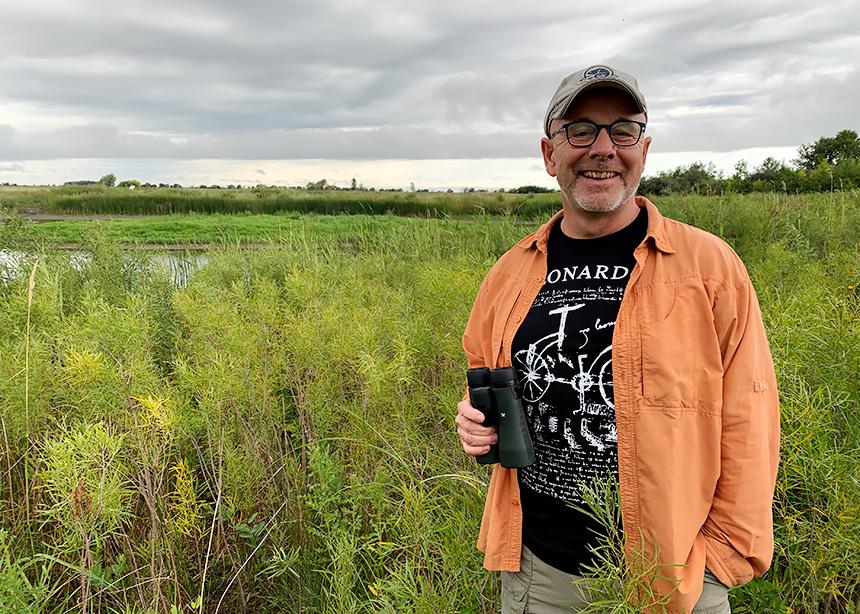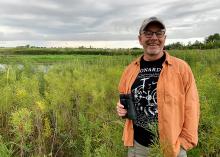I don’t get out much.
That’s true for my personal life. My wife and I are homebodies and we jokingly refer to ourselves as “indoor kids”—a nod to the kind of children who choose watching TV or reading a book over getting outside and running around.
It’s also true for my work life. Since Canadian Mennonite is based in Waterloo and I live in Winnipeg, I work from home. Many of the interviews I do are conducted by phone, so I don’t often leave my house when I’m on the clock.
Working from home has its advantages, but it can sometimes end up being too much time in my house.
So I was excited when Alvin Dyck invited me to go birding. Alvin is a member at Douglas Mennonite, the church where I grew up, and he’s good friends with one of my uncles. He’s also a seasoned educator with a graduate degree in zoology. His interest in birding began in the mid-1980s.
When I decided to write an article about Canadian Mennonites who enjoy birding, Alvin was the first person I contacted. I suggested a phone interview, but he had something better in mind.
That’s how I found myself walking around Oak Hammock Marsh, a wetland and birding hotspot located 20 km north of Winnipeg, on a Friday morning last month.
Within minutes of my arrival, Alvin had given me a pair of binoculars and was pointing out—among others species—trumpeter swans, barn swallows, harriers, black terns and purple martins. (I’m proud to say I had heard of three of those prior to the outing.)
I had expected Alvin to identify birds by their physical appearance, which he did. But as a novice birder, I was surprised when he identified far-off birds based on the way they moved while in flight. He also pointed out birds that we couldn’t see based on the sounds they made.
“The work that I end up doing with birds now, it’s almost all by sound,” said Alvin, who contributes to a variety of citizen science initiatives including annual bird counts and surveys.
“When we’re doing surveys, you don’t see most of them—you hear them,” he said. “That was a whole other world that opened up [when I became a birder], and that took a long time [to learn]. And I’m still learning all the time.”
My time with Alvin provided a great introduction to the world of birding, which I further explored by talking with five birders from across Canada.
I’m thankful to Alvin, Gordon Janzen, John Pries, Merri-Lee Metzger, Asher Warkentin and Rosie Perera for the insight they provided into why they are birders and how it connects to their faith.
They spoke about things like slowing down, paying attention, spending time with others, appreciating creation and connecting with God.
Those are certainly things this indoor kid can get behind. I’m looking forward to going birding again.
Other highlights
Other highlights in this digital issue of Canadian Mennonite include an article by Emily Summach exploring what community life looks like for the small congregation of Springridge Mennonite Church, located near Pincher Creek, Alberta.
John Longhurst provides some final thoughts on “Memories of Migration,” the tour that took place last month commemorating the arrival of Russlaender Mennonites in Canada from 1923 to 1930.
In the latest From Our Leaders column, Josh Wallace from Mennonite Church Saskatchewan reflects on what a recent bout with COVID—his first—taught him.
Elsewhere in the issue, MennoMedia outlines its plans for a commemorative book that will capture the diverse and inspiring stories of Anabaptist witness from around the globe. Congregations are encouraged to submit photos and story ideas.
As always, CM invites your feedback. Send your emails to letters@canadianmennonite.org.
Aaron Epp is associate editor at Canadian Mennonite.
Read more editorials:
Of beets and chainsaws
Uncommon global access
The poofy blue MCC couch
The duty of tension
Countering intuition




Add new comment
Canadian Mennonite invites comments and encourages constructive discussion about our content. Actual full names (first and last) are required. Comments are moderated and may be edited. They will not appear online until approved and will be posted during business hours. Some comments may be reproduced in print.